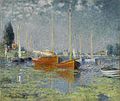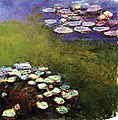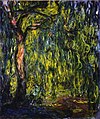Paintings of Claude Monet
Sainte-Adresse, 1866,Musée d'Orsay, Paris.
Women in a Garden,1866–1867, Musée d'Orsay, Paris.
Woman in a Garden, 1867,Hermitage, St. Petersburg
Jardin à Sainte-Adresse,1867, Metropolitan Museum of Art, New York City
The Magpie, 1869. Musée d'Orsay, Paris.
Seine Basin with Argenteuil, 1872, Musée d'Orsay, Paris.
Jean Monet on his hobby horse, 1872, Metropolitan Museum of Art, New York.
Camille Monet on a Garden Bench, 1873,Metropolitan Museum of Art, New York.
The Artist's house at Argenteuil, 1873, The Art Institute of Chicago
Poppies Blooming, 1873,Musée d'Orsay, Paris.
Train in the Snow, 1875,Musée Marmottan Monet, Paris.
Madame Monet in a Japanese Costume, 1875,Museum of Fine Arts, Boston
Woman with a Parasol,(Camille and Jean Monet), 1875, National Gallery of Art, Washington, DC.
Camille Monet at her tapestry loom, 1875,Barnes Foundation,Merion, PA
Argenteuil, 1875, Musée de l'Orangerie, Paris.
The Boat Studio, 1876,Barnes Foundation,Merion, PA
Saint Lazare Train Station, Paris, 1877, The Art Institute of Chicago
Rue Montorgueil, 1878,Musée d'Orsay, Paris.
Vétheuil in the Fog, 1879,Musée Marmottan Monet, Paris.
Camille Monet on her deathbed, 1879, Musée d'Orsay, Paris.
Lavacourt: Sunshine and Snow, 1879–1880National Gallery, London
Later life
After several difficult months following the death of Camille, a grief-stricken Monet (resolving never to be mired in poverty again) began in earnest to create some of his best paintings of the 19th century. During the early 1880s, Monet painted several groups of landscapes and seascapes in what he considered to be campaigns to document the French countryside. His extensive campaigns evolved into his series' paintings.
Camille Monet had become ill with tuberculosis in 1876. Pregnant with her second child she gave birth to Michel Monet in March 1878. In 1878 the Monets temporarily moved into the home of Ernest Hoschedé, (1837–1891), a wealthy department store owner and patron of the arts. Both families then shared a house in Vétheuil during the summer. After her husband (Ernest Hoschedé) became bankrupt, and left in 1878 for Belgium, and after the death of Camille Monet in September 1879, and while Monet continued to live in the house in Vétheuil; Alice Hoschedéhelped Monet to raise his two sons, Jean and Michel, by taking them to Paris to live alongside her own six children.[14] They were Blanche Hoschedé Monet, (she eventually married Jean Monet), Germaine, Suzanne Hoschedé, Marthe, Jean-Pierre, and Jacques. In the spring of 1880, Alice Hoschedé and all the children left Paris and rejoined Monet still living in the house in Vétheuil.[15] In 1881, all of them moved toPoissy, which Monet hated. In April 1883, looking out the window of the little train between Vernon and Gasny, he discovered Giverny[16][17][18]. They then moved to Vernon, then to a house in Giverny in Normandy, where he planted a large garden and where he painted for much of the rest of his life. Following the death of her estranged husband, Alice Hoschedé married Claude Monet in 1892.[5]
Giverny

At the beginning of May 1883, Monet and his large family rented a house and 2 acres (8,100 m2) from a local landowner. The house was situated near the main road between the towns of Vernonand Gasny at Giverny. There was a barn that doubled as a painting studio, orchards and a small garden. The house was close enough to the local schools for the children to attend and the surrounding landscape offered many suitable motifs for Monet's work. The family worked and built up the gardens and Monet's fortunes began to change for the better as his dealer Paul Durand-Ruel had increasing success in selling his paintings. By November 1890, Monet was prosperous enough to buy the house, the surrounding buildings and the land for his gardens. During the 1890s, Monet built a greenhouse and a second studio, a spacious building well lit with skylights. Beginning in the 1880s and 1890s through the end of his life in 1926, Monet worked on "series" paintings, in which a subject was depicted in varying light and weather conditions. His first series exhibited as such was of Haystacks, painted from different points of view and at different times of the day. Fifteen of the paintings were exhibited at the Galerie Durand-Ruel in 1891. He later produced several series of paintings including: Rouen Cathedral, Poplars, the Parliament, Mornings on the Seine, and theWater Lilies that were painted on his property at Giverny.
Monet was fond of painting controlled nature: his own gardens in Giverny, with its water lilies, pond, and bridge. He also painted up and down the banks of the Seine, producing paintings such as Break-up of the ice on the Seine. He wrote daily instructions to his gardener, precise designs and layouts for plantings, and invoices for his floral purchases and his collection of botany books. As Monet's wealth grew, his garden evolved. He remained its architect, even after he hired seven gardeners.[19]
Between 1883 and 1908, Monet traveled to the Mediterranean, where he painted landmarks, landscapes, and seascapes, such as Bordighera. He painted an important series of paintings in Venice, Italy, and in London he painted two important series—views of Parliament and views of Charing Cross Bridge. His second wife, Alice, died in 1911 and his oldest son Jean, who had married Alice's daughter Blanche, Monet's particular favourite, died in 1914.[5] After his wife died, Blanche looked after and cared for him. It was during this time that Monet began to develop the first signs of cataracts.[20]
During World War I, in which his younger son Michel served and his friend and admirer Clemenceau led the French nation, Monet painted a series of weeping willow trees as homage to the French fallen soldiers. In 1923, he underwent two operations to remove his cataracts: the paintings done while the cataracts affected his vision have a general reddish tone, which is characteristic of the vision of cataract victims. It may also be that after surgery he was able to see certain ultraviolet wavelengths of light that are normally excluded by the lens of the eye, this may have had an effect on the colors he perceived. After his operations, he even repainted some of these paintings, with bluer water lilies than before the operation.[21]
Later paintings
The Artist's Garden at Vétheuil, 1880, National Gallery of Art
La maison du pêcheur à Varengeville (The Fisherman's house at Varengeville), 1882,Museum Boymans-van Beuningen, Rotterdam
The Cliffs at Etretat, 1885,Clark Art Institute,Williamstown, Massachusetts
Haystacks, (sunset), 1890–1891, Museum of Fine Arts, Boston
Poplars, (autumn), 1891,Philadelphia Museum of Art
Four Poplars on the Banks of the Epte River nearGiverny, 1891,Metropolitan Museum of Art
The Seine at Giverny, 1897, National Gallery of Art
Bridge over a Pond of Water Lilies, 1899,Metropolitan Museum of Art
Poplars on the Epte, 1900,National Gallery of Scotland, Edinburgh
Water Lilies, 1906, Art Institute of Chicago
Water Lilies, 1907, Bridgestone Museum of Art, Tokyo
Palace From Mula, Venice, 1908, National Gallery of Art, Washington, D.C.
The Grand Canal, Venice1908, Boston Museum of Fine Arts
Water Lilies, 1914–1917,Toledo Museum of Art,Toledo, Ohio
Nympheas, 1915, Neue Pinakothek, Munich
Nympheas, 1915, Musée Marmottan Monet
White and yellow Water Lilies, (1915 -1917),Kunstmuseum Winterthur,Winterthur, Switzerland
Nympheas, c. 1916,Musée Marmottan Monet,Paris
Water Lilies, 1916, The National Museum of Western Art, Tokyo
Water Lilies and Reflections of a Willow(1916–19), Musée Marmottan Monet
Water Lilies, 1917–1919,Honolulu Academy of Arts
Weeping Willow, 1918–1919, Kimball Art Museum,Fort Worth
Water Lilies, 1919,Metropolitan Museum of Art, New York City
Sea-Roses (Yellow Nirwana), 1920, The National Gallery, London
Water-Lily Pond, c. 1915–1926, Chichu Art Museum,Naoshima, Kagawa, Japan
The Rose-Way in Giverny,1920–1922, Musée Marmottan Monet
Death
Monet died of lung cancer on 5 December 1926 at the age of 86 and is buried in the Giverny church cemetery.[22] Monet had insisted that the occasion be simple; thus only about fifty people attended the ceremony.[23]
His home, garden and waterlily pond were bequeathed by his son Michel, his only heir, to the French Academy of Fine Arts (part of the Institut de France) in 1966. Through the Fondation Claude Monet, the house and gardens were opened for visit in 1980, following restoration.[24] In addition to souvenirs of Monet and other objects of his life, the house contains his collection of Japanese woodcut prints. The house is one of the two main attractions of Giverny, which hosts tourists from all over the world.
Posthumous sales

In 2004, London, the Parliament, Effects of Sun in the Fog (Londres, le Parlement, trouée de soleil dans le brouillard) (1904), sold for US$20.1 million.[25] In 2006, the journal Proceedings of the Royal Society published a paper providing evidence that these were painted in situ at St Thomas' Hospital over the river Thames.[26]
Falaises près de Dieppe (Cliffs near Dieppe) has been stolen on two separate occasions. Once in 1998 (in which the museum's curator was convicted of the theft and jailed for five years and two months along with two accomplices) and most recently in August 2007.[27] It was recovered in June 2008.[28]
Monet's Le Pont du chemin de fer à Argenteuil, an 1873 painting of a railway bridge spanning the Seine near Paris, was bought by an anonymous telephone bidder for a record $ 41.4 million at Christie's auction in New York on 6 May 2008. The previous record for his painting stood at $ 36.5 million.[29] Le bassin aux nymphéas (from the water lilies series) sold at Christie's 24 June 2008, lot 19,[30] for £36,500,000 ($71,892,376.34) (hammer price) or £40,921,250 ($80,451,178) with fees, setting a new auction record for the artist.[31]
Nympheas – Water Lilies sold for USD 71,846,600. . This was one of the highest prices paid for Monet's work.



























































 ترجمه متون تخصصی فنی و مهندسی انگلیسی به فارسی و بالعکس در اسرع وقت با بهترین کیفیت و قیمت مناسب توسط : مهندس جعفر ارشادی فرد ISI مقالات دانشگاهی
ترجمه متون تخصصی فنی و مهندسی انگلیسی به فارسی و بالعکس در اسرع وقت با بهترین کیفیت و قیمت مناسب توسط : مهندس جعفر ارشادی فرد ISI مقالات دانشگاهی